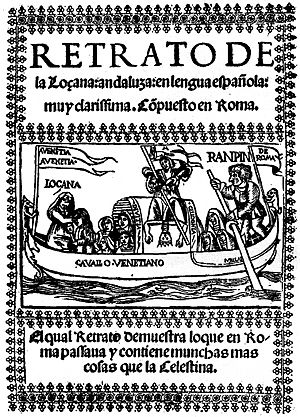Portrait of Lozana: The Lusty Andalusian Woman facts for kids

Retrato de la Loçana andaluza..., Venice, 1528.
|
|
| Author | Francisco Delicado |
|---|---|
| Original title | Retrato de la Loçana andaluza |
| Translator | Bruno M. Damiani |
| Country | Spain |
| Language | Spanish |
| Genre | Novel |
| Publisher | Scripta Humanistica |
|
Publication date
|
1528 (English trans. August 1987) |
| Media type | Print (Hardback) |
| Pages | 301 pp (Eng. Trans. hardback edition) |
| ISBN | 0-916379-41-8 (Eng. Trans. hardback edition) |
| OCLC | 15695720 |
| 863/.3 19 | |
| LC Class | PQ6388.D2 E5 1987 |
The Portrait of Andalucian Lozana is an old Spanish book. Its original Spanish title is Retrato de la Loçana andaluza. Francisco Delicado, a Spanish writer from the Renaissance period, published it in Venice in 1528. He had to leave Rome because people there were upset with Spaniards. This happened after Rome was attacked in 1527.
The book was published without the author's name. It describes daily life in Rome during the early 1500s. It especially focuses on women who had moved there from Spain and southern Italy. The book is one of the first to talk about women making and selling beauty products. It is seen as a follow-up to La Celestina, another famous Spanish book. This is because both are written as a "novel in dialogue," like a play. It is also one of the earliest examples of a picaresque novel. This type of story follows a clever, often mischievous, main character. Only one copy of this book still exists today. It is kept in the National Library of Austria in Vienna.
Story of Lozana
The story starts in Cordoba, Spain. A girl named Aldonza lives there with her mother. After her mother dies, she moves in with her aunt. Aldonza then runs away with a sea merchant named Diomedes. They travel to many cities around the Mediterranean Sea and the Middle East. Aldonza changes her name to Lozana during their travels.
They arrive in Marseille to meet Diomedes' father. But his father is angry with Diomedes. He sends his son to prison. He also pays a sailor to make Lozana disappear. However, the sailor does not follow the order. Instead, he takes Lozana to Livorno. From there, she continues her journey to Rome.
Lozana has no money when she reaches Rome. She goes to the Spanish area of the city to ask for help. The women there soon notice her skills. She is very good at cooking and making beauty products. A woman from Naples gives Lozana a servant named Rampin. Lozana and Rampin agree that he will work for her for a while. After a few years, Lozana and Rampin move to Lipari. The book ends with a short description of the attack on Rome in 1527.
What the Book Means
One important thing about this book is its teaching and funny side. Like other picaresque novels, it shows the problems in Rome's society. It talks about many different people, from important leaders to ordinary citizens. This makes the book a clear and real look at life in Rome from 1513 to 1524. It also hints at the attack on Rome by Charles V's forces in 1527. This event marked the end of the first part of the Renaissance.
The story itself does not reach the year 1527. But there are hints that predict this ending. It suggests that bad things will happen to Rome because of its problems. The author even writes, "When the year twenty-seven arrives, leave Rome and go away." This was seen as a warning about the consequences of people's actions.
Film Adaptations
A Spanish-Italian film based on the book was made in 1975.
See also
 In Spanish: La Lozana andaluza para niños
In Spanish: La Lozana andaluza para niños

